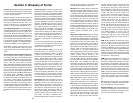28
Outputs: Electrical signals sent from the PCM.
These signals may activate relays or other actua-
tors for control purposes throughout the vehicle.
The signals can also send information from the
PCM to other electronic modules, such as the
ignition or trip computer.
PCM: Powertrain Control Module. The “brains” of
the engine control system. It is a computer
housed in a metal box with a number of sensors
and actuators connected with a wiring harness.
Its job is to control fuel delivery, idle speed, spark
advance timing, and emission systems. The PCM
receives information from sensors, then ener-
gizes various actuators to control the engine. The
PCM is frequently called the ECM (Engine Control
Module) in vehicles having other computers.
These other computers are used for climate
control, entertainment systems, transmissions,
etc.
PROM: Programmable Read-Only Memory. A
small, replaceable electrical component hidden
behind an access door on the PCM. The PROM
contains permanent programming information
the PCM needs to operate a specific vehicle
model. Included are vehicle weight, engine and
transmission type, axle ratio, and other specifics.
Relay: A mechanical device for switching high
current circuits on and off. It is electronically
controlled by a low current circuit. Relays allow a
low power PCM signal to control a high power
device such as an electric cooling fan.
ROM: Read-Only Memory. Permanent program-
ming information stored inside the PCM, contain-
ing the information the PCM needs to operate a
specific vehicle model.
Sensor: Device which gives the PCM informa-
tion. The PCM can only work with electrical
signals. The job of the sensor is to take some-
thing the PCM needs to know, such as engine
temperature, and convert it to an electrical signal
that the PCM can understand. The PCM uses
sensors to measure such things as throttle posi-
tion, coolant temperature, engine speed, incom-
ing air mass and temperature, etc.
SFI or SEFI: Sequential Fuel Injection or Se-
quential Electronic Fuel Injection. A fuel injection
system that uses one or more injectors for each
cylinder. The injectors are mounted in the intake
manifold, and are fired individually in the same
sequence as the spark plug firing order.
Solenoid: A device to convert an electrical signal
to mechanical movement. It consists of a coil with
a wire with a moveable metal rod in the center.
When the power is applied to the coil, the
resulting electromagnetism moves the rod and
performs some mechanical action. The PCM
often uses solenoids to switch vacuum lines on
and off. This allows the PCM to control vacuum
operated devices such as the EGR valve. Fuel
injectors are operated by another type of sole-
noid.
TBI: Throttle Body Injection. A fuel injection
system having one or more injectors mounted in
a centrally-located throttle body, as opposed to
positioning the injectors close to an intake valve
port. Also called Central Fuel Injection (CFI) in
some vehicles.
Thermistor: A resistor whose resistance changes
with temperature. Thermistors are used as sen-
sors for vehicle coolant and manifold air tempera-
ture. The resistance decreases as temperature
goes up, sending a voltage signal to the PCM
where it is converted to a temperature measure-
ment.
Throttle Body: A device which performs the same
function as a carburetor in a fuel injection system.
On a throttle body injection (TBI) system, the
throttle body is both the air door and the location
of the fuel injectors. On port fuel injection systems
(PFI, MPFI, SFI, etc.) the throttle body is simply
an air door. Fuel is not added until the injectors
at each intake port are activated. In each case,
the throttle body is attached to the accelerator
pedal.
Vehicle Adapter: Like General Motors and the
ALDL connector, Ford and Chrysler use Vehicle
Adapter as the name of their diagnostic link. Ford
uses a 7-pin adapter called the EEC-IV self test
adapter. This is generally located in the engine
compartment of Ford vehicles, though specific
location varies (generally it is close to the PCM).
Chrysler has a similar adapter for access to the
Serial Communications Interface (SCI) diagnos-
tic program on those vehicles that support SCI.
This adapter is located on the right-hand side of
the engine compartment, and is a 6-pin configu-
ration. This adapter is usually near the Logic
Controller on the SCI computer.
29
VIN: Vehicle Identification Number. This is the
factory-assigned vehicle serial number. This num-
ber is stamped on a number of locations through-
out the vehicle, but the most prominent location
is on top of the dashboard on the driver’s side,
visible from outside the car. The VIN includes
information about the car, including where it was
built, body and engine codes, options, colors,
and a sequential build number. The VIN can also
tell you what adapters you may need to use the
ScanTool with your particular vehicle.
WOT: Wide-Open Throttle. The vehicle operating
condition brought about when the throttle is
completely (or nearly so) open. The PCM will
typically deliver extra fuel to the engine and de-
energize the A/C compressor at this time for
acceleration purposes. The PCM uses a switch
or the Throttle Position Sensor to identify the
WOT condition.

















